
Australia’s CSIRO focuses on developing methods and technologies that hold promise for the mining industry’s four major
areas: exploration, mining, processing and metals production.
CSIRO Helps Mining Industry Work More Efficiently
After a number of traditional global R&D leaders ‘dropped the ball’—due to funding cuts,
industry disinterest or complacency—Australia saw an opportunity, seized the initiative
and became a world leader in mining-technology innovation
By John Miller, Australian Editor

The CSIRO’s Minerals Down Under Flagship works across the minerals value chain to deliver science and technology solutions that will help grow Australia’s resource base, increase the productivity of the minerals industry and reduce its envi-ronmental footprint, both in Australia and globally. The flagship’s director, Jonathan Law, said CSIRO is working with industry partners to develop technologies that assist the industry and also deliver positive flow-on effects into other challenging areas such as soil salinity, water quality and waste utilization.
Jonathan Law said the work of CSIRO is very important to Australia’s mining indus-try in two ways:
•It takes a long-term view of the mining in-dustry in Australia so it looks at the chal-lenges in 10 or 15 years rather than the
short-term challenges of today. It has the
freedom because of the government in-vestment and its resources to take the
long-term view and work on technologies
that will be important but that can’t be de-livered in a two- or three-year timeframe.
•It has a very strong engagement with in-dustry on a day-to-day basis, working on
the operations and issues faced daily.
About 50% of the revenue comes from in-dustry and CSIRO works closely with this
sector, which makes sure it is aligned with
what the current challenges are.
The mining industry is global and CSIRO’s work is also important at a global level. “Many of those we work with in Australia are global miners looking to deploy technologies around the world. Because many of the challenges the indus-try faces are shared globally and not par-ticularly conducive to economic competi-tiveness, many countries are happy to work with Australia to develop solutions that are generally good for the industry,” Law said.
“There’s a whole range of factors like productivity, energy and water factors that have the potential to drive the industry out of business, and people are generally happy to share technologies in that space. Being connected globally is very important for us in terms of making sure we work with the best companies and organizations around the world. Having said that, we always try to make sure we deliver benefits for Australia. A lot of our technologies are based on Australia-specific challenges in which case we are happy to lead.”
CSIRO has brought together a portfolio of activities in the Minerals Down Under Flagship, he said. “About 10 years ago the organization took a look at itself and asked the question: Are we really working on the most important big picture things for Australia? There was a view that we were probably working on too many things in too many diverse areas and that we didn’t have a long-term strategy for real impact in some of the big national challenges, and this resulted in the National Research Flagship program led by CSIRO.
“Five years ago the Minerals Down Under Flagship was formed in recognition that the minerals industry was important to Australia but in the longer term faced some serious challenges. We integrated capabilities across the organization to focus on the full value chain of the mining industry in four key areas: exploration, mining, mineral processing and metal production. Most importantly we wanted to focus on sustainabili-ty—how do we cope with low grades and more complex ores in terms of the implica-tions for water and energy, and how do we make sure the industry is well linked beyond just the minerals industry into manufactur-ing and services. Almost A$15 billion a year comes from Australia’s services to mining sector, so there is an enormous opportunity for us and it is a global opportunity.”
Assisting Explorers
“If exploration is not successful in the
longer term the industry will not grow,”
Law explained. “With this in mind we try to
ensure explorers working in Australia have
access to the very best precompetitive
data. We work closely with Geoscience
Australia and the state surveys, and have
worked with them on the AuScope GRID
project. This is world-leading national data
sharing infrastructure that enables data
right across all geological surveys to be
delivered in a seamless way.”
Law said the most recent initiative is delivery of an ASTER (Advanced Space-borne Thermal Emission and Reflection) map. “ASTER is satellite-borne technology that enables you to map the surface of the planet and particularly to make inferences about the mineralogy of the surface. Working with Geoscience Australia and the state and territory surveys we have produced an inte-grated map of Australia that shows for the first time the broad mineralogical variations across the country. It is very important for exploration and for a range of other things, such as water management, agricultural management and the impact of the mining industry relative to other industries.
“The philosophy is to get people here, make them think Australia is prospective, give them the very best data for free, pro-vide effective exploration tools and let them loose to start exploring and be suc-cessful,” said Law. “As soon as we released this map, we had inquiries from other countries saying can you do this for us? It is technology we can export to other countries and we are happy to do that.”
The flagship is developing a technology called ‘ReMoTe,’ which addresses the problem of getting skilled people on mine sites for maintenance or repairs. Law said having an expert on site at the right time is a challenge because you never know when you are going to strike a problem.
“We have developed this technology involving the use of a camera on a hard-hat that lets you interact through video and sound with somebody in another city or anywhere you like over the Internet,” Law said. “They can actually see what you can see in front of you and they can, through a monitor on your side, point to what you should be doing. It provides a real time interaction with someone who can visualize what you are doing and can direct you to undertake the repair.”
Mineral Processing
Technology
In mineral processing, CSIRO has new tech-nology based on ore sorting. Law said it’s a
way of measuring on a conveyor belt the
mineralogical composition of ore. “It has
been the holy grail of processing for quite
some time, but because of the volumes of
rock passing through the big mines, we
haven’t been able to deploy it in a useful
way. We have developed a prototype instru-ment that can analyze a section of belt in a
couple of seconds and let you make a deci-sion about where [the material] goes in the
process route. This will have a big impact on
the amount of water and energy used in pro-cessing because you are not using those
resources on waste material.
“Sensors and sensor technology are going to become more important, and a big opportunity for us is the use of real-time sensing to deliver the ‘digital revolution’ to mining,” he continued. “There are all sorts of information we should be getting there in real time and should be making decisions based on it.
“Also in processing we are keen to come up with technologies that let us exploit big resources that we know about but for whatever reason can’t be economi-cally exploited. One of the big areas for this work is nickel laterites. In Australia about two-thirds of our nickel resource is nickel laterite, but most production comes from sulphides, so sooner or later we have to make that transition. The Pacific Rim countries all have these nickel laterites which would benefit from new technology. One of the things that makes processing difficult is that they consume enormous amounts of acid when you try to leach the laterite which requires expensive capital equipment and involves high ongoing costs because that leaching must be done at a high temperature.
“Instead of using sulphuric acid we are working with Sydney-based company Direct Nickel to use nitric acid rather than sul-phuric acid,” said Law. “The clever thing about this technology is that you can replenish the nitric acid and don’t have to keep bring in tons of new acid, which has a huge impact on operational costs and has the real potential to make some of the Australian nickel laterites competitive again. You also don’t have to do it at high temperature so you don’t have the big cap-ital costs of having to build the containers for high temperature and pressure leaching.
“We are working closely with nickel companies in this process, which is one of the underlying principles of the flagship— we want our technology to be relevant and used by industry,” he said. “As soon as we possibly can in this type of work we get industry to come on board and co-fund the research but we also try to bring in a tech-nology provider that can deliver the com-mercialized product. We can only have an impact if we work with companies to commercialize these technologies.”
Future Challenges
One of the challenges for the mining indus-try in the future, according to Law, is that
Australia is an expensive source of labor, and
just about everything else that goes into min-ing, so for Australia to remain globally com-petitive it has to improve its productivity.
“This, in turn, is a challenge for CSIRO and takes us down a route of automation and skills development so that we can maintain the fantastic infrastructure Australia has by attracting the very best people in the world and then keeping them in Australia. We have a core role to deliver those things in the future.”
He said the most important factor fac-ing the industry into the future is commu-nity perceptions that play into politics, and funding, and directly into the future of the industry.
“CSIRO will continue to invest in Australia’s minerals industry as it remains broadly supported by the community, and a valued part of the national economy. Sharing the risks and benefits of the resource busi-ness is an area in which we, as an industry, have to do better. Being a nationally funded flagship, I see that as an important role for us to play discussing the impacts of the mining industry and how we can do that bet-ter, and talking to all stakeholders.
“One of our major activities is ‘mineral futures’ which is all about leading thinking in what technologies will make a difference in the future, how will people perceive those technologies, how do different stakeholders in the community want us to proceed with R&D around the minerals industry and how can we link in with things like manufactur-ing, which is going through very hard times. Wouldn’t it be great if we could have a man-ufacturing industry that leverages off our strength in minerals and starts to build min-eral-related products that we could send off-shore. In this way when Australia runs out of minerals, we have something else and are a global leader in manufacturing and services.
“Sliding commodity prices are another challenge for the industry,” he said, “and these are beyond our control, but generally speaking as commodity prices fall, compa-nies are less inclined to co-invest with us, particularly with longer term R&D, as they focus on the short-term. We can’t afford to operate as solely an Australian research enti-ty—we have to work with the big players all over the world. This is a challenge for us— how do we take the Australian expertise and work with the very best overseas without giv-ing away the family farm in the process.”
The amount of money being spent on greenfields exploration is declining at an alarming rate, Law said, so not only is there less money available for juniors but they are not spending on greenfields exploration in Australia and around the world because brownfields exploration is cheaper and more likely to provide quick success. “We put a lot of effort into technology to help with greenfields exploration. If we can drag peo-ple out of brownfields areas and into new areas, those are where the big wins will be.”
World Technology Leader
In many ways, Australia is leading the
world in mining technology because some
others that were leading dropped the ball,
according to Law—think of the dramatic
changes in historically major industry play-ers including the U.K., and parts of the
U.S. and Europe.
“These places had strong R&D cultures and strong minerals industries but when the community tide turned against those industries, the infrastructure that went with it lapsed—the services and R&D—so there is a lesson for Australia. The other fundamental, is that Australia has a long history of mining which has allowed it to build up a credible R&D portfolio and take a leading role as others have dropped off,” Law said. “The federal government has also played a major role because they have been prepared to support the industry with ventures such as CSIRO and CRCs (Cooperative Research Centers) where money is put into longer term challenges with a clear focus on practical research outcomes.
“The industry has also got its act together in Australia in a way that no other country has been able to do—through AMIRA International, an industry-funded collaborative research vehicle—which has enabled companies to come together and work on shared problems. We can probably do even more and focus on bigger things as a collegiate group of industry people. This goes back to the community opinion on mining—if the industry is seen to be out there investing in its own future, that can only be a positive thing for the entire indus-try because not only does it get the bene-fits from the R&D but it demonstrates that it’s an industry that thinks about its future, that has a future in Australia and is pre-pared to put its money behind that.”
Jonathan Law sees Australia’s role in mining technology growing in the future. “We would be crazy to let it die. There’s a fantastic opportunity for us to grab and there are competitors such as Canada, Latin America and Africa who are also in this space, but I don’t think they are as well positioned as we are. I think there is a big future in R&D and particularly around the commercialization of R&D, which in the longer term is where the real money is going to be for the nation so we really need to nurture that.”
John Miller is editor of The Asia Miner, a Mining Media International publication
Technology Drives Improved Productivity
Australia’s mining industry relies on tech-nological innovation to drive improved pro-ductivity, according to Australian Minister
for Resources and Energy Martin Ferguson.
Speaking at the recent opening of a glob-al mining research and development center in Perth, Western Australia, Ferguson said research conducted at the center would effectively contribute to the global competi-tiveness of the Australian mining industry, helping to maximize returns to the commu-nity and shareholders. It’s a theme that read-ers will encounter repeatedly in the following section: a summary of recent Australia-based mining technology and product intro-ductions, compiled by the staff of E&MJ’s sister publication, The Asia Miner, Mining Media’s bimonthly journal covering mining-related news and events in the Asia Pacific region. The Asia Miner is based in Mel-bourne, Victoria, and enjoys wide distribu-tion within the Australian mining sector.
The research center that served as the sounding board for Ferguson’s comments is affiliated with BASF, a leading global chemical company. The new facility will allow BASF’s scientists to study specific innovation needs for mineral processing and metal production to help reduce ener-gy consumption and reuse water at mines in Australia and around the world.
BASF SE Vice Chairman Dr. Martin Brudermueller, whose management re-sponsibilities include the Asia Pacific region, said at the opening: “Chemistry is a key enabler to making tomorrow’s mining industry more sustainable. With the latest advances in mining solutions research, BASF aims to help mining operations to minimize water consumption, maximize recovery, reduce land areas consumed by tailings disposal and minimize the cost and time required to rehabilitate sites.”
With a team that will comprise six advanced material researchers at the BASF center by the end of 2012 and about 20 researchers over the next five years, focus topics will include advanced rheology mod-ifiers for the improvement of the thicken-ing process for valuables and tailings, as well as modification of the crystallization process in alumina production.
“High quality ores are becoming deplet-ed and new mines are often in hostile loca-tions while environmental, health and safe-ty regulations are becoming more strin-gent. BASF aims to help the industry face these challenges with solutions across our customers’ value chain. This new research and development center will further devel-op our expertise in areas, that are crucial to meeting future needs,” said Dr. Steffen Kudis, head of BASF’s Global Oilfield and Mining Solutions businesses.
The following pages of highlighted technological developments within the Australian mining sector are roughly cate-gorized by their association with the extrac-tion, processing, information technology and safety/training sectors of the industry.
MINING

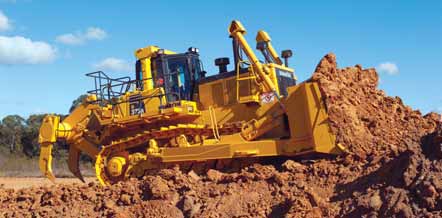
Haulage Partnership with
Canadian Diamond Mine
A number of extended-distance mine haul
trucks with purpose-built dump bodies are
heading from Australia to the Ekati diamond mine in northern Canada during the
second half of 2012. As reported in
Austmine’s Export News, one Haulmax
3900-D with special lightweight body
developed by Duratray is the first of the
Tasmanian-built trucks to be supplied to
Ekati, with more to come.
“[The 3900-D] is the first of a fleet of units to be used on their Misery satellite mine project,” said Bob Calvert, Haulmax global marketing manager and Austmine board member. The 80-ton-payload truck will haul material more than 35 km to a stockpile in testing conditions. He said winter temperatures could drop to -60°C. Three more units are expected to be deliv-ered later this year in time to use the 2013 ice road to the mine.
“The Duratray is a common sight at that operation,” Calvert said. “Haulmax worked with Duratray Australia to develop a body specifically for the Haulmax unit design. The body was built in Melbourne, fitted to the 3900 and shipped direct to Canada as a complete unit. It was selected in this instance to ensure the flexible body liner will maintain material fluidity over the longer haulage distance and time, reducing the risk of it freezing.”
A Duratray Australia spokesperson said there were more than 30 different trucks at Ekati with Duratray Suspended Dump Bodies (SBDs). “The body has all the trademarks of the Suspended Dump Body, with rubber floor, rubber front wall and all the key benefits needed for icy conditions such as no carry back, impact and vibra-tion reduction due to the suspended effect, and reduced maintenance.”
“The client specifically requested a [Duratray] body. The request was purely based on Ekati’s experience with the SDB bodies, it just happened to be that the new design was a long haul which was a new challenge for us,” the spokesperson said.
Komatsu Enhances Dozer
Ride-comfort Levels
Construction and mining equipment man-ufacturer Komatsu Australia has increased
the ride comfort levels of its mining dozers.
Komatsu’s Mining Product Manager David
Laidlaw said several major modifications
have been made to the cab mountings to
reduce shock loads and the undercarriage’s
bogie and equalizer oscillation angles.
“Following trials in Hunter Valley and central Queensland coal mines, we can confirm that the ride, vibration levels and operator comfort on Komatsu mining doz-ers are as good as or better than any other machine. We carried out a rigorous inde-pendent testing program, comparing a D475A-5EO with the ride enhancement package fitted, a machine without the package and a competitive machine. The results show that we have achieved our ride and operator comfort objectives.”
Further testing is continuing into addi-tional ways to improve the ride and comfort levels for the dozers. Komatsu has also developed a factory-fitted Australian min-ing specification package which allows dozers to be delivered ‘mine ready’ direct from the factory to the mine site. The pack-age includes features such as right and left-hand access platforms with handrails and access lights, starter isolator box, man-ual engine stop switch and engine bay maintenance light. This option will save companies considerable time and expense when preparing and delivering dozers to mine operations.
“It ensures that mine specification requirements for our dozers are manufac-tured and installed to Komatsu’s exacting production standards prior to being shipped to Australia, and that they comply to ISO engineering standards,” Laidlaw said.
ReCoila Tackles Underground
Blasting Challenge
An Australian-made lightweight hose reel
has been instrumental in solving a chal-lenge to plug a breakthrough hole in an
underground blasting operation. Mining
consumables company MTI Group
approached ReCoila to supply a hose reel
that would be durable and easily transportable in order to position a plugging
device in holes up to 90 m deep.
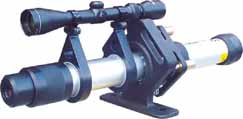
MTI wanted to load the holes with explosives for further blasting but needed the breakthrough hole—a downhole drilled between levels which breaks through to an open tunnel with limited access—plugged first. Making the entire process even more challenging was the extremely harsh work-ing environment to which the solution was being exposed. ReCoila supplied a medium duty steel hand crank reel suited to long hose lengths, to which MTI added addi-tional controls to remotely manipulate inflatable devices at the end of the hose.
Other brands of hose had already failed to withstand the rugged conditions of the task, but MTI said the ReCoila hose reel was ideal. “MTI has told us the orientation of the inlet worked well with the control box that was necessary for its specific applications. The control box housed a pneumatic circuit, giving the ability to inflate and evacuate plugs from above ground,” said ReCoila Managing Director Michael Pawson.
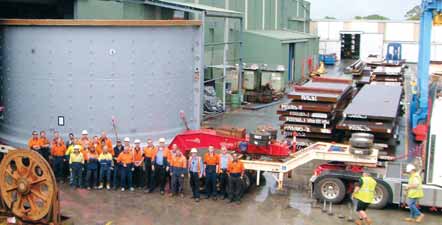
MTI Group specializes in products used for blasting, specifically to suspend, confine and locate explosive charges using inflata-bles. It operates throughout Australia and abroad with about 30 hose reels in opera-tion in underground mines in Australia and the United States.
Australian-made Tunneling Lasers Australia has a home-grown solution for accurate tunneling lasers, made by MCE Lasers, which said its tunneling laser range delivers accurate construction and align-ment of tunnels driven by tunnel boring machines, drill and blast, pipe jack or con-ventional hand techniques. MCE Lasers is a 30-year-old Australian company that spe-cializes in the manufacture and design of lasers for alignment and leveling. According to MCE, the full range of lasers is rugged, made from materials such as stainless steel, anodized aluminum and brass. The lasers incorporate diode tech-nology and can be powered by a variety of battery supplies, from D cells to LR44 bat-teries, suited to the customer’s operating time and physical size requirements. The range offers a unique array of features such as user-defined, focusable green or red beam for extra long range; single and dual beam lasers; line generator optics; beam splitter optics; and intrinsically safe lasers for use in explosive areas. MCE Lasers said it has also developed an extensive range of laser levels, receivers and measuring units for the global market.
MINERAL PROCESSING
World’s Largest Mill Shells
Hofmann Engineering, which has participat-ed in expansions of capability at plants in
Western Australia and Victoria by supplying
large-diameter grinding mill heads and
shells, reported that June 2012 saw the dis-patch of the first stainless steel-lined mill
shell and heads for one of three 9.15 x
14.2-m autogenous grinding mills at Barrick
Gold’s Pascua Lama gold-silver project on
the border between Chile and Argentina.
The mill shell is manufactured in three cylindrical cans, each split longitudinally into semicircles for transport. The weight of each autogenous mill being manufactured by Hofmann at its Bassendean plant in Perth is 516 tons, consisting of 10 pieces.
Two additional mills will be delivered over the coming six months. Three even larger mill shells are now on order for client FLSmidth Minerals, to be installed at iron ore and copper projects in South America. When completed these will be some of the largest grinding mills in service.
The company also notes its Hofalloy-forged steel girth gears for grinding mills, kilns and calciners have achieved major milestones in new orders. What is believed to be the largest forged steel gear in the world will be delivered to Metso Minerals for a new project in north Asia. This 13.2-m-diameter gear, weighing more than 80 tons, will be driven by two 8,500-kW case-carburized pinions that are also being sup-plied by Hofmann Engineering as part of the drivetrain for a new 36-ft-diameter SAG mill. Meanwhile, an even higher-pow-ered single-pinion drive of 9,000 kW has been designed by the Hofmann Mill Gearing team to be supplied to FLSmidth for a large ball mill drive at a new gold project in northern Canada.
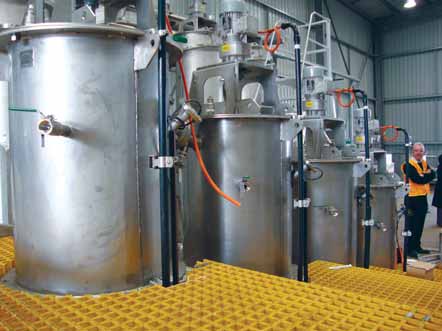
Non-Toxic Gold Recovery
Alternative to Cyanide
CSIRO is developing a gold recovery process
to treat high-grade gold concentrates onsite
at mines, which it claims will eliminate the
use of the toxic chemical cyanide and
reduce the risk of theft. The process, thio-sulfate, is what CSIRO is investigating as an
non-toxic alternative to cyanide for recover-ing gold from ores and concentrates.
CSIRO Research Leader Dr. Paul Breuer said industry wants to move away from cyanide because of the perceived environmental risk and because it is already banned in some areas where gold mining takes place.
“Companies are reluctant to ship the gold concentrate offsite for further cyanide processing because even though the gold content is not high, it is of considerable value and there is a risk of theft during transportation.
“By recovering the gold from these concentrates onsite, the industry can get an increased return on their mining. This is where thiosulfate comes in. Gold can be dissolved using thiosulfate and then recov-ered from solution onsite to produce gold doré, which can then be easily transported using armored guards to minimize the risk of theft.”
CSIRO has worked with industry to develop this environmentally sustainable process in the laboratory and piloting is planned for later this year.
“CSIRO is also developing a thiosul-fate-based process for the recovery of gold from pyritic ores and for the in-situ or in-place leaching of gold from ores,” Breuer said. “The in-situ or in-place leaching offers significant reduction in the environ-mental impacts of mining as the surface is not disturbed, other than for a series of injection and extraction wells.”
PNG Laterite Ore to Undergo
Innovative Process Testing
After joint venture partners Regency Mines
and Direct Nickel (DNi) established a
maiden resource at the Mambare nickel
project in Papua New Guinea, their next
important step is to pilot a 150-ton sample
of ore at DNi’s test plant in Perth using its
patented, pioneering nickel laterite pro-cessing technology. DNi said the testing
will produce comprehensive engineering
data for use in pre-feasibility studies.
The Direct Nickel Process is a hydro-metallurgical process for laterite deposits. It is believed to be the only process capa-ble of treating the full laterite profile, from limonitic to saprolitic ores, in a single flow-sheet. It is a tank-leach process that oper-ates at atmospheric pressure, or with the option of mild pressure, and treats the ore at relatively low temperatures.
The leach process uses a special reagent package to liberate in two to four hours more than 95% of the nickel, cobalt and other metals into solution. The insoluble residue is neutralized and sent to a waste disposal facility. The solution is then sequentially processed to extract the individual metals.
So far, DNi has spent A$25 million on developing, testing and patenting its process. A demonstration plant has been built in Perth and the company has farmed into joint ventures in Indonesia and Papua New Guinea. Australia’s CSIRO is also involved in development of the technology.
The maiden JORC-compliant resource for Mambare stands at 95 million mt at 0.96% nickel and 0.08% cobalt, using a 0.6% nickel cut-off, for almost 1 million mt of contained nickel.
A 2009 external study by Aker Solu-tions showed the Direct Nickel Process is economic using a slightly higher head grade than the maiden resource. With dis-covery of a higher-grade saprolite layer and further drilling of the plateau, the target is to identify a large resource or equal or bet-ter grade than the maiden estimate.
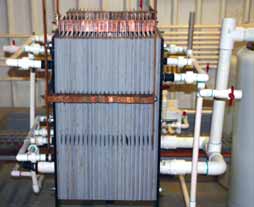
Proto Develops Nickel
Laterite Technology
Proto Resources, through its majority-owned subsidiary Barrier Bay, said it also is
developing technology that could unlock
the real value of laterite nickel deposits
and provide the nickel industry with a def-inite path to a strong and profitable future.
To process nickel laterite economically, the
Barrier Bay process utilizes low capex and
opex technology based on the use of elec-tricity to process waste byproducts into
reusable acid and saleable metal products.
Laterite ore bodies contain high levels of other elements such as cobalt, iron and magnesium that call for different processing methods, with the most common forms cur-rently used being high pressure acid leach-ing (HPAL) and heap leaching. Under these methods ore is processed in a sulphuric acid leach to extract the metal. The nickel/cobalt solution is then separated and purified by solvent extraction and electrowinning.
This requires large capex for an acid plant, plus pressure and heat apparatus for HPAL and opex for acid, acid transport and byproduct storage. It also leaves a large environmental footprint as byproducts including sulphuric acid, and iron and magnesium salts must be neutralized and stored in a tailings dam.
Proto’s processing technology involves leaching the ore at room temperature and atmospheric pressure, and then transfer-ring the pregnant leach solution, or PLS, into an electrochemical cell divided by a membrane. When electricity is passed through the cell, iron oxide and magne-sium hydroxide come out of solution (attaching to the cathode) and the sul-phuric acid in solution regenerates in one half of the cell with water collecting in the other. The nickel and cobalt are extracted using ion exchange (IX) resin and then electrowon, producing nickel metal.
According to the company, when com-pared to the HPAL method of processing laterite ore the Barrier Bay process stacks up well. Sulphuric acid can represent up to 70% of operating costs on HPAL projects. By recycling up to 90% of the acid, the Barrier Bay process could provide large cost savings from recycling such vast quantities of acid and water in the process in addition to being able to extract saleable iron and magnesium products and drastically re-duce the size of tailings storage facilities. The process is believed to work on any pro-ject that uses sulphuric acid as a reagent.
Development of the process began in 2007 at an independent laboratory in northern New South Wales. Proto has fund-ed the construction of a pilot plant to test the process on a larger scale and this pilot-ing is in the final stages. The data gained from the pilot continues to inform Proto and its joint venture partner on their Barnes Hill nickel-cobalt deposit in Tasmania.
INFORMATION TECHNOLOGY

Transmin’s Rocklogic Wins
Innovation Award
Materials handling company Transmin
topped competition within the innovation
category in the 21
st Annual Western
Australian Information Technology and
Telecommunications Awards. Transmin’s
Rocklogic, a rockbreaker automation sys-tem, was one of 27 finalists for the awards,
which recognize companies and individuals
at the cutting edge of technology innovation.
Rocklogic claims to be the only auto-mated system applied to hydraulic boom and hammer assemblies used to reduce the size of material in crushing operations at hard-rock mine sites. The Australian-engineered technology provides integrated remote operation, collision avoidance and automated parking technology for rock-breakers. Transmin said the system improves mine site safety by eliminating hazards to site personnel.
Transmin Senior Engineer Dr. Adrian Boeing presented the Rocklogic system at the Collision Avoidance in Mining Conference in Brisbane, earlier this year. “Remote operation protects the operator’s health by removing them from exposure to dangerous mining conditions, allowing them to operate the equipment from a safe office environment,” he said. “This can either be on site or at a city-based control room where operators can control several rockbreakers at different sites around the state.
“Our collision avoidance technology significantly increases safety and elimi-nates downtime and maintenance costs from collisions. Operators also feel more confident knowing a collision system is protecting them, and this improves their operating speed and efficiency. The system can also be integrated with industry stan-dard fleet management systems to avoid collisions with vehicles. Rocklogic’s fault tolerant dedicated emergency shutdown system is customized to each site’s needs and ensures the health and safety of all surrounding personnel,” Boeing said.
Each rockbreaker carries sensors, specifically fitted to calculate its position relative to surrounding plant. This information is used to compute the nearest obstacles to the rockbreaker and preemptively reduce its speed to avoid collisions. In addition, Rocklogic can generate movement plans for the rockbreaker that it can automatically follow, allowing the operator to park the rock-breaker with the touch of a button.
“Our system is unique because of its 3-D data. We use CAD data or a laser scan of the mine site to produce a virtual layout of the rockbreaker’s surrounds,” said Daniel Adams, Rocklogic’s lead technical engineer. “With that information and the sensors fit-ted, we determine where the Rockbreaker is within the scene to prevent it from colliding with nearby objects or structures.”
Mining ERP on Your
Smartphone
MinePoint ERP software, developed in
Australia on the Microsoft Dynamics AX
platform, delivers on the promise of mobile
business information. “MinePoint is fully-featured ERP, but that isn’t what you need
when you’re stuck in an airport lounge.
What you really need is to carry on with
business as usual and know that essential
data and information isn’t trapped back at
the office—it’s there with you, available on
your phone,” said Bill Jarman, business
manager at Eclipse Computing, developers
of MinePoint.
MinePoint was developed by Eclipse to address the challenges faced by Australian mining companies with operations in fast-growing mining regions such as Mongolia, Africa and South America. Workflows initi-ated in the MinePoint ERP, such as pur-chase orders, payment approvals and main-tenance work orders, are made available for immediate action via smart devices without the need for a dedicated Internet connec-tion. This means operational workflow isn’t compromised when an approving manager is traveling or is off-site.
MinePoint’s ERP functionality supports the full mining lifecycle from exploration to production and can be deployed interna-tionally with a range of options depending on the site and communications infrastruc-ture available. This flexibility is under-pinned by comprehensive international compliance matched by multi-currency, multi-lingual and international support for more than 30 countries as well as local tax, regulatory and market requirements.
“MinePoint has the familiar look and feel of all Microsoft products. That means it’s easy to get up and running in countries where English is a second language. The simple user interface and direct integration with Word, Excel and Outlook means less training and less stress on the ground,” said Jarman.
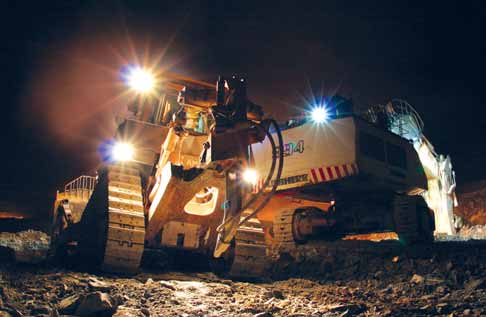
Pitram Optimum Operates
in Ghana
MICROMINE has successfully implement-ed its mine control and management
reporting solution, Pitram Optimum, at
Gold Fields’ Damang gold mine in Ghana.
MICROMINE said Pitram will help the
operation to increase production, reduce
costs, and improve safety and business
intelligence capabilities.
Damang is an open-pit gold mine in southwest Ghana, at which Gold Fields annually processes 5.1 million metric tons annually from a blend of approximately 37% oxide ore and 63% fresh ore. The current planned depth of the Damang pit is 300 m and it is estimated that the current mineral reserve will be depleted by 2019, although exploration work indicates that the life of mine could be extended if addi-tional projects are approved.
Gold Fields’ FMS and projects supervi-sor Barrett Blaauw said Pitram was select-ed “because of its ability to integrate the production planning and optimization process into the real-time environment. The software went ‘live’ in February 2012. This is the first time Gold Fields has worked with MICROMINE, which provides us with good after-sales services and tech-nical support.
“The biggest hurdle for us has been convincing operators in the field to utilize the new software to their advantage. Fortunately, an increasing number of min-ers in Africa are experiencing the benefits that automation solutions such as Pitram provide.
“Both our Ghanaian mines have ambi-tious expansion plans that could extend their lives. A strong fleet is essential to our current and future operations. Damang has 22 automated vehicles and using Pitram Optimum, we plan to automate a further 12 vehicles within the next few months.”
Pitram Optimum is one of four solu-tions that comprise the Pitram product suite, which provides an upgrade path from the entry-level Pitram Report solution, through to the fully automated Pitram Optimum Solution.
MICROMINE’s South Africa General Manager Marc Ramsey said, “Because Pitram Optimum integrates production planning and optimization, Damang will see a significant improvement in the exe-cution of mine plans and the maximization of asset utilization and efficiency. Damang management will be able to compare actual findings against plans, and have the ability to correct deviations from plans.
“Also, through intuitive equipment allo-cation, Damang can optimize production, reduce wait time and execute shift plans according to design or blending require-ments. This will allow business targets to be achieved at the lowest possible cost,” Ramsey noted.
Mining Information Portal
Sees Enhancements
Mining Information Systems (MIS) has
added new tools to its MISWeb Control
Platform that enhance usability and effi-ciency: the OLAP cube viewer (Scout) and
a dashboard reporting tool (Focus) that
both provide clear, crisp graphics and data
visualizations together with strong analytic
capabilities.
The MISWeb Control Platform is a high-ly scalable, enterprise-wide data and appli-cation end user portal. This portal also pro-vides a data analytics suite of web applica-tions that is claimed to provide sophistica-tion with simplicity in a synergistic Web-based interface for navigating MIS applica-tions or consuming Microsoft Analysis Services OLAP cubes.
The MIS team has implemented data management and reporting systems specif-ic to the mining industry at a large number of surface and underground mines around the globe. There are more than 40 installa-tions of the MIS product range in Africa, Australia, North and South America, and Canada. The systems, or modules therein, have been used as a primary data reporting and management tool in the mining of a number of commodities, including coal, copper, diamonds, gold, iron ore, mineral sands, nickel, tantalum, uranium and vanadium.
According to the company, the Mine Management Reporting System (MMRS) has at its core a global database model that is not constrained by language, time zones, unit of measure, currency, organi-zational structure or commodity mined. The system has been designed and devel-oped to be implemented in a modular fashion, facilitating a staged deployment strategy that simplifies on-site user training and acceptance.
MMRS modules correspond to all the functional areas of a mining operation including load and haul, drill and blast, product and stockpile tracking, fuel system management, fixed plant and crushing, geology, grade control and performance to physical or financial plans, forecasts and budgets. The systems contain full featured data analysis Cube creation and built in analysis and dashboarding tools using familiar drag-and-drop technologies.
SAFETY AND TRAINING
Bis Industries Drivers Roll
Safely with Optalert
Bis Industries said it has taken a high-tech
approach to fatigue management on its
Boddington to Bunbury copper concentrate
haulage project in Western Australia.
Sharing roads with a myriad of local drivers, vacationers, tourists and farmers, this route demanded driver risk mitigation that Bis Industries effected through the use of innovative fatigue monitoring tech-nology, Optalert. As described in a recent issue of E&MJ(See “Homing In on the Human Factor in Haulage Risk Reduction,” p. 84, June 2012), the Optalert system employs a unique set of driving eyewear. The glasses—connected to a small computer processor in the vehi-cle—emit and detect low levels of infrared light to sense movements in the eyes and eyelids. Data regarding these movements are fed into the computer, which calculates a driver’s level of drowsiness.
Optalert was installed on six prime movers and one light vehicle. Bis Industries Divisional Risk and OHSE man-ager Toro Havini said, “almost 95% of the time our road trains are sharing the road with the public, [and] often these passenger vehicles are holiday makers who may have never seen a road train before and at times they don’t understand the stopping distances and crash avoidance spaces required when interacting with that type of heavy vehicle. We wanted Optalert on this operation as we understand that fatigue is a critical risk in our business and we want to do every-thing to ensure that we not only meet our legislative responsibili-ties but exceed them.
“We want to use technology that is at the cutting edge of fatigue management,” he said. “Our drivers often report back near-misses where passenger vehicles do dangerous things in an effort to overtake a road train or pull out in front of them, not understanding that such a heavy vehicle needs more stopping and crash avoidance space. That’s why it is so critical that our drivers are 100% alert and totally vigilant to the actions of those around them.”
The Optalert system has been in full use since early May, with very positive driver feedback following an extensive debrief and training program run by senior Bis Industries management. Havini said, “[Fatigue management] is a very human issue and while experience helps keep it in control, it only takes one ‘micro sleep’ to cause a tragedy, especially at the wheel of a road train.
“The key to the success of this roll out has been the support of Optalert and the lengthy debrief session they had with drivers to iron out any concerns or issues. Bis Industries has had a long-standing relationship with Optalert and we have had times when the system was used successfully and also times when it was not so successful. Any time you are an early adopter of high technol-ogy, you will encounter teething issues, but we have worked close-ly with Optalert over the years to iron out those issues and as a result our feedback has gone into making the system more rugged and suitable for mining and outback road conditions. The result is a product that we have a lot of faith in.”
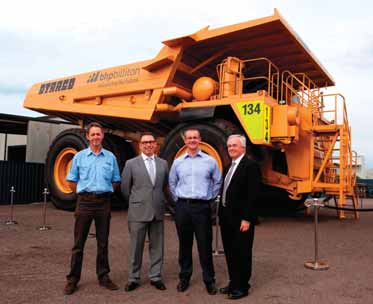
Training Facility for Tire Fitters
Otraco International has opened a custom-designed, off-road tire-fitting training center in Perth, from which it aims to train hun-dreds of graduates in certified automotive-mechanical heavy tire
fitting. Otraco said the new facility will train tire fitters in the com-pany’s operations at sites across Australia, and help address the
shortage of qualified off-road tire fitters.
The center comprises a large tire pad, training rooms, offices, workshop and hardstand. Otraco said it offers a simulated mine environment with trainees able to work on real mining equipment. “One of the most important advantages of this approach is that it enables trainees to undergo training in a very safe, controlled environment. It also enables them to decide whether they like the life, as trainees will be required to work a full mine roster, work nights, undergo mock client audits and even eat in a crib room,” said Otraco general manager Alistair Swanson.
Trainees will attend the center for the first six weeks of the cer-tificate and then continue their training at mine sites. Mining com-panies and local businesses have equipped the center with both open-pit and underground mining machinery, including a Caterpillar 789B haul truck from BHP Billiton and an Elphinstone R2900 bogger and tire handler from Downer Mining.
BHP Billiton Iron Ore’s Head of Community and Indigenous Affairs Richard O’Connell, said his company supports the center as it provides a real-life practical training experience. “We under-stand the importance of skill development to meet the needs of our growing Western Australian community. Equally, we are com-mitted to reinforcing a culture of safety and best practice.”
The center will initially take groups of six to eight students to meet the needs of Otraco’s operation, while commercial courses to mining equipment companies will be offered at a later date.
Otraco is owned by diversified mine contractor Downer EDI Mining. The company’s tire-management software system, OTRACOM, provides tire-management expertise with the latest advances in online web technology. This combination enables clients to access real-time data via the Internet.
Otraco’s subsidiary Rimtec is a global distributor of tire accessories, sealants and lubricants as well as earthmover wheels and rims. This offers clients com-plementary services and ensures ongoing in-house support for Otraco’s core tire-management business.
Komatsu Invests in Employee
Talent Development
The first class of students has begun a two-year course under Komatsu Australia’s
graduate development program (GDP). The
training program is part of the company’s
strategy to further progress its talent devel-opment goal to ensure there is a steady
supply of specialist and management
expertise in the sector.
Komatsu’s Managing Director Sean Taylor, said the company has made consid-erable investments in training and human resources development in recent years. “The GDP builds on such programs as our award-winning apprentice development sys-tem for plant and heavy machinery appren-tices, as well as our certified technic accreditation system which recognizes tech-nical skills and competency excellence.”
The new course is focused on building organizational capability in critical busi-ness areas and has recruited a number of recent graduates from various disciplines including three engineering graduates and one each from IT, finance/accounting and business/commerce.
“The program aims to give the gradu-ates an opportunity to develop skills and experience in a range of business areas to prepare them for a career within Komatsu,” said Taylor.
Each graduate will spend time in vari-ous Komatsu departments at different locations on rotational assignments, from which they will then provide a 30-minute presentation to management. Taylor said this is a major initiative for the company to build its organizational capability and max-imize its long-term business sustainability. Graduates who successfully complete the program will be offered ongoing employment with Komatsu.
This strategy will produce future leaders for the company, said Komatsu’s Business Skills Development Manager Jason Alfeo. “Our executive team and divisional man-agers are the sponsors of the program; we intend to provide a unique and exclusive Komatsu learning experience for the grad-uates that will expand the pool of future leaders available to the business.”
A feature of the program is its goal of developing ‘the whole person.’ Komatsu’s National Organizational Development Manager Paul Richardson said, “We con-centrate not only on further developing their technical skills relative to their cho-sen discipline, but also their practical life and business skills.”
The skills development areas include project management, career planning, pub-lic speaking, negotiation, conflict resolution, problem solving, OH&S, customer service and emotional intelligence—all aimed at increasing the students’ corporate success. The first class of six students was selected from 550 applicants.